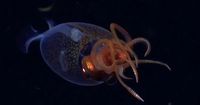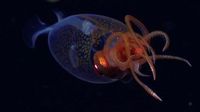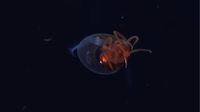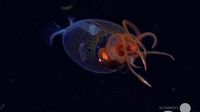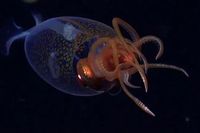In a groundbreaking moment for marine biology, scientists have captured the first-ever video of a colossal squid, a creature that has long been shrouded in mystery. The footage was recorded by an international team of researchers from the Schmidt Ocean Institute using a remotely operated submersible during an expedition near the South Sandwich Islands, revealing a juvenile specimen of the species Mesonychoteuthis hamiltoni at a depth of approximately 600 meters.
The sighting, which occurred on March 9, 2025, showcases a squid that is not yet fully grown, estimated to be around 30 centimeters long. Experts classify it as a "colossal adolescent," as the species can reach lengths of up to seven meters and weigh more than 500 kilograms. This remarkable achievement marks a significant milestone in the study of one of the ocean's most elusive inhabitants.
For over a century, the colossal squid has captured the imagination of scientists and the public alike, often regarded as a modern myth within marine biology. The first scientific identification of the species dates back to 1925 when biologist James Erik Hamilton discovered remains of a colossal squid in the stomach of a sperm whale near the South Shetland Islands. Since then, knowledge about the species has been pieced together primarily through remains found in the stomachs of predators or caught in fishing nets.
Prior to this expedition, all recorded sightings of colossal squids had involved dead or dying specimens. However, the recent video not only confirms the existence of live specimens in their natural habitat but also provides a crucial window into the early stages of their life cycle. The squid was filmed by a camera aboard the vessel R/V Falkor, which is equipped to explore depths of up to 4,500 meters.
The Schmidt Ocean Institute's recent expedition is part of a larger initiative known as the Ocean Census, which aims to document and protect marine biodiversity. This particular journey lasted 35 days and focused on uncovering new marine life while collaborating with various scientific organizations.
During the expedition, researchers also recorded the first confirmed footage of the glass squid, Galiteuthis glacialis, in the Bellingshausen Sea earlier this year, further emphasizing the importance of these explorations in expanding our understanding of marine ecosystems.
According to experts, the colossal squid is the heaviest known invertebrate, and its life cycle remains largely undocumented. As they mature, these squids lose their transparency and are believed to descend to even greater depths, making them difficult to study. The recent footage opens up new avenues for research, allowing scientists to observe their behavior, movement, and feeding patterns for the first time.
Previously, the only known predators of adult colossal squids were sperm whales and certain species of sharks. The squid's elusive nature and the challenges of studying them in their deep-sea environment have contributed to the lack of knowledge about their life cycle and ecological role.
This discovery is not just a scientific triumph; it also serves as a reminder of the vast, unexplored territories of our oceans. With more than 80% of the ocean yet to be mapped, explored, and understood, findings like these underscore the significance of oceanic research and conservation efforts.
As the Schmidt Ocean Institute continues its mission, the hope is that such explorations will yield further insights into other mysterious marine species and contribute to the preservation of marine biodiversity. The footage of the colossal squid is a testament to the potential for discovery that lies beneath the waves, waiting to be uncovered.
In conclusion, the first video of a live colossal squid not only enriches our understanding of this enigmatic species but also highlights the ongoing need for marine exploration and conservation. As researchers continue to study these magnificent creatures, the mysteries of the deep ocean may gradually be revealed, offering a glimpse into a world that has remained largely hidden from human eyes.
